FIAT DUCATO BASE CAMPER 2015 Owner handbook (in English)
Manufacturer: FIAT, Model Year: 2015, Model line: DUCATO BASE CAMPER, Model: FIAT DUCATO BASE CAMPER 2015Pages: 367, PDF Size: 19.73 MB
Page 251 of 367
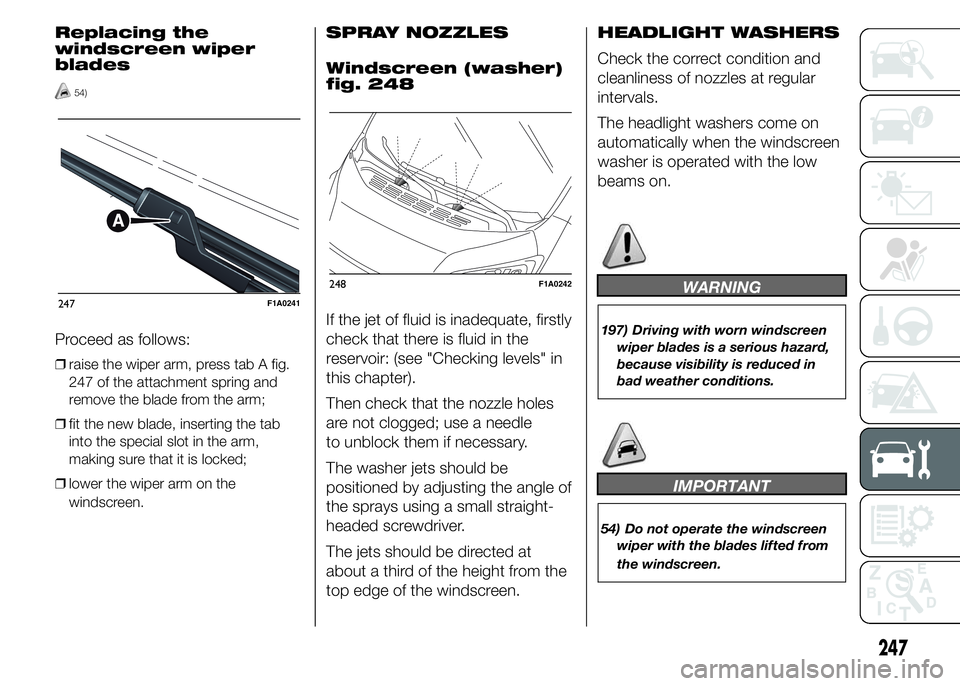
Replacing the
windscreen wiper
blades
54)
Proceed as follows:
❒raise the wiper arm, press tab A fig.
247 of the attachment spring and
remove the blade from the arm;
❒fit the new blade, inserting the tab
into the special slot in the arm,
making sure that it is locked;
❒lower the wiper arm on the
windscreen.
SPRAY NOZZLES
Windscreen (washer)
fig. 248
If the jet of fluid is inadequate, firstly
check that there is fluid in the
reservoir: (see "Checking levels" in
this chapter).
Then check that the nozzle holes
are not clogged; use a needle
to unblock them if necessary.
The washer jets should be
positioned by adjusting the angle of
the sprays using a small straight-
headed screwdriver.
The jets should be directed at
about a third of the height from the
top edge of the windscreen.HEADLIGHT WASHERS
Check the correct condition and
cleanliness of nozzles at regular
intervals.
The headlight washers come on
automatically when the windscreen
washer is operated with the low
beams on.
WARNING
197) Driving with worn windscreen
wiper blades is a serious hazard,
because visibility is reduced in
bad weather conditions.
IMPORTANT
54) Do not operate the windscreen
wiper with the blades lifted from
the windscreen.
247F1A0241
248F1A0242
247
Page 252 of 367
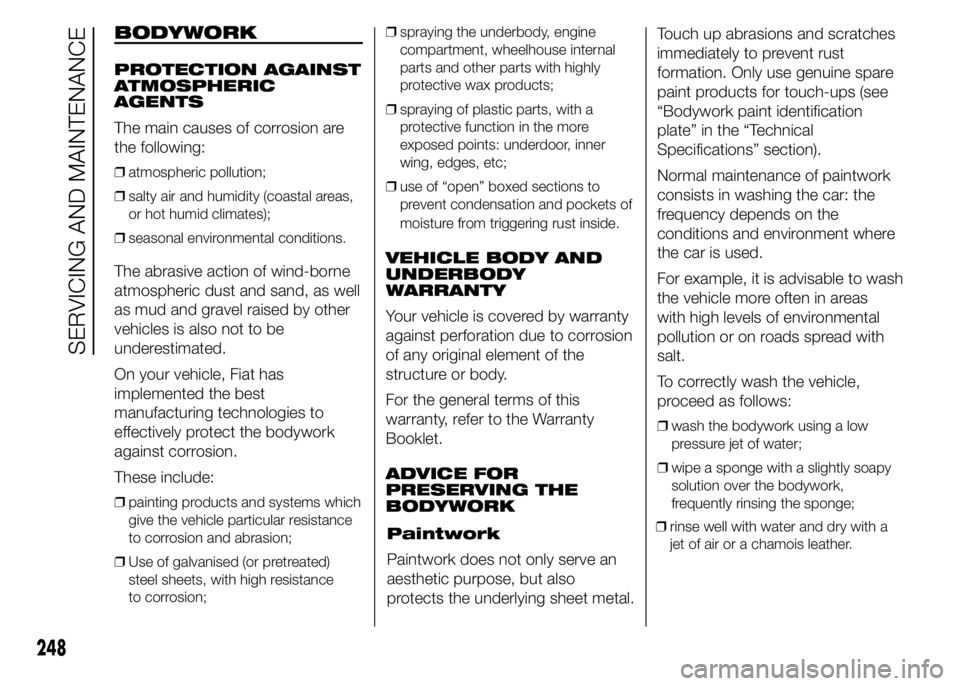
BODYWORK
PROTECTION AGAINST
ATMOSPHERIC
AGENTS
The main causes of corrosion are
the following:
❒atmospheric pollution;
❒salty air and humidity (coastal areas,
or hot humid climates);
❒seasonal environmental conditions.
The abrasive action of wind-borne
atmospheric dust and sand, as well
as mud and gravel raised by other
vehicles is also not to be
underestimated.
On your vehicle, Fiat has
implemented the best
manufacturing technologies to
effectively protect the bodywork
against corrosion.
These include:
❒painting products and systems which
give the vehicle particular resistance
to corrosion and abrasion;
❒Use of galvanised (or pretreated)
steel sheets, with high resistance
to corrosion;❒spraying the underbody, engine
compartment, wheelhouse internal
parts and other parts with highly
protective wax products;
❒spraying of plastic parts, with a
protective function in the more
exposed points: underdoor, inner
wing, edges, etc;
❒use of “open” boxed sections to
prevent condensation and pockets of
moisture from triggering rust inside.
VEHICLE BODY AND
UNDERBODY
WARRANTY
Your vehicle is covered by warranty
against perforation due to corrosion
of any original element of the
structure or body.
For the general terms of this
warranty, refer to the Warranty
Booklet.
ADVICE FOR
PRESERVING THE
BODYWORK
Paintwork
Paintwork does not only serve an
aesthetic purpose, but also
protects the underlying sheet metal.Touch up abrasions and scratches
immediately to prevent rust
formation. Only use genuine spare
paint products for touch-ups (see
“Bodywork paint identification
plate” in the “Technical
Specifications” section).
Normal maintenance of paintwork
consists in washing the car: the
frequency depends on the
conditions and environment where
the car is used.
For example, it is advisable to wash
the vehicle more often in areas
with high levels of environmental
pollution or on roads spread with
salt.
To correctly wash the vehicle,
proceed as follows:
❒wash the bodywork using a low
pressure jet of water;
❒wipe a sponge with a slightly soapy
solution over the bodywork,
frequently rinsing the sponge;
248
SERVICING AND MAINTENANCE
❒rinse well with water and dry with a
jet of air or a chamois leather.
Page 253 of 367
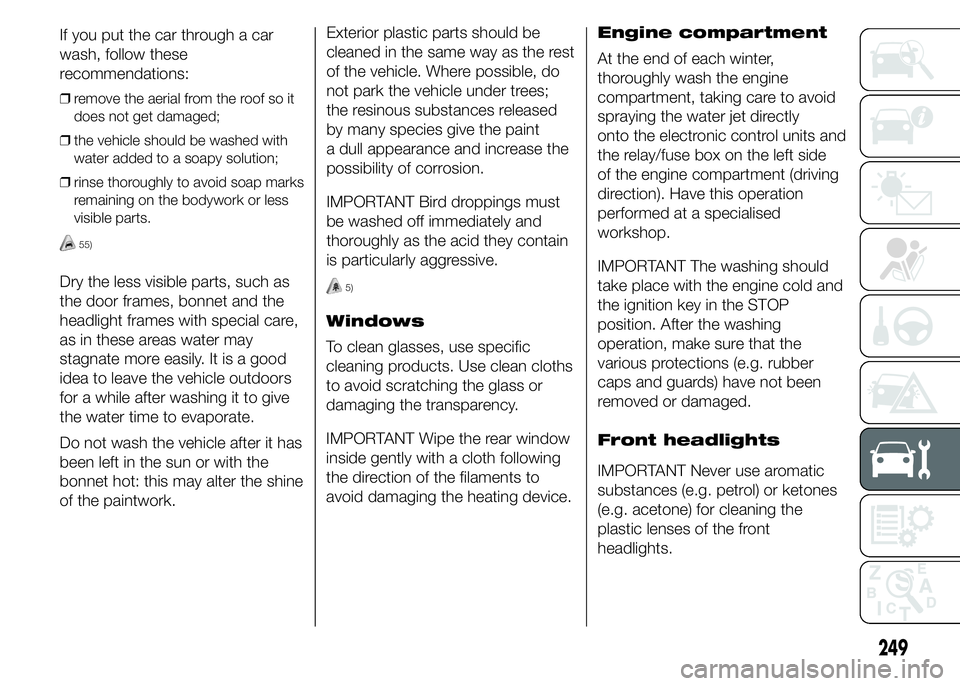
If you put the car through a car
wash, follow these
recommendations:
❒remove the aerial from the roof so it
does not get damaged;
❒the vehicle should be washed with
water added to a soapy solution;
❒rinse thoroughly to avoid soap marks
remaining on the bodywork or less
visible parts.
55)
Dry the less visible parts, such as
the door frames, bonnet and the
headlight frames with special care,
as in these areas water may
stagnate more easily. It is a good
idea to leave the vehicle outdoors
for a while after washing it to give
the water time to evaporate.
Do not wash the vehicle after it has
been left in the sun or with the
bonnet hot: this may alter the shine
of the paintwork.Exterior plastic parts should be
cleaned in the same way as the rest
of the vehicle. Where possible, do
not park the vehicle under trees;
the resinous substances released
by many species give the paint
a dull appearance and increase the
possibility of corrosion.
IMPORTANT Bird droppings must
be washed off immediately and
thoroughly as the acid they contain
is particularly aggressive.5)
Windows
To clean glasses, use specific
cleaning products. Use clean cloths
to avoid scratching the glass or
damaging the transparency.
IMPORTANT Wipe the rear window
inside gently with a cloth following
the direction of the filaments to
avoid damaging the heating device.Engine compartment
At the end of each winter,
thoroughly wash the engine
compartment, taking care to avoid
spraying the water jet directly
onto the electronic control units and
the relay/fuse box on the left side
of the engine compartment (driving
direction). Have this operation
performed at a specialised
workshop.
IMPORTANT The washing should
take place with the engine cold and
the ignition key in the STOP
position. After the washing
operation, make sure that the
various protections (e.g. rubber
caps and guards) have not been
removed or damaged.
Front headlights
IMPORTANT Never use aromatic
substances (e.g. petrol) or ketones
(e.g. acetone) for cleaning the
plastic lenses of the front
headlights.
249
Page 254 of 367
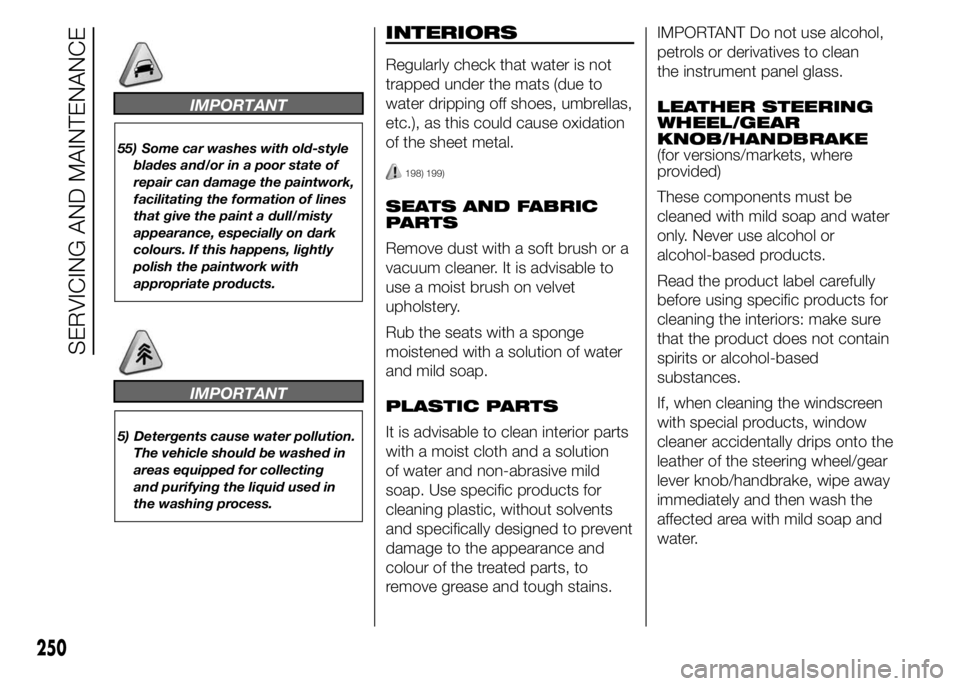
IMPORTANT
55) Some car washes with old-style
blades and/or in a poor state of
repair can damage the paintwork,
facilitating the formation of lines
that give the paint a dull/misty
appearance, especially on dark
colours. If this happens, lightly
polish the paintwork with
appropriate products.
IMPORTANT
5) Detergents cause water pollution.
The vehicle should be washed in
areas equipped for collecting
and purifying the liquid used in
the washing process.
INTERIORS
Regularly check that water is not
trapped under the mats (due to
water dripping off shoes, umbrellas,
etc.), as this could cause oxidation
of the sheet metal.
198) 199)
SEATS AND FABRIC
PARTS
Remove dust with a soft brush or a
vacuum cleaner. It is advisable to
use a moist brush on velvet
upholstery.
Rub the seats with a sponge
moistened with a solution of water
and mild soap.
PLASTIC PARTS
It is advisable to clean interior parts
with a moist cloth and a solution
of water and non-abrasive mild
soap. Use specific products for
cleaning plastic, without solvents
and specifically designed to prevent
damage to the appearance and
colour of the treated parts, to
remove grease and tough stains.IMPORTANT Do not use alcohol,
petrols or derivatives to clean
the instrument panel glass.
LEATHER STEERING
WHEEL/GEAR
KNOB/HANDBRAKE
(for versions/markets, where
provided)
These components must be
cleaned with mild soap and water
only. Never use alcohol or
alcohol-based products.
Read the product label carefully
before using specific products for
cleaning the interiors: make sure
that the product does not contain
spirits or alcohol-based
substances.
If, when cleaning the windscreen
with special products, window
cleaner accidentally drips onto the
leather of the steering wheel/gear
lever knob/handbrake, wipe away
immediately and then wash the
affected area with mild soap and
water.
250
SERVICING AND MAINTENANCE
Page 255 of 367
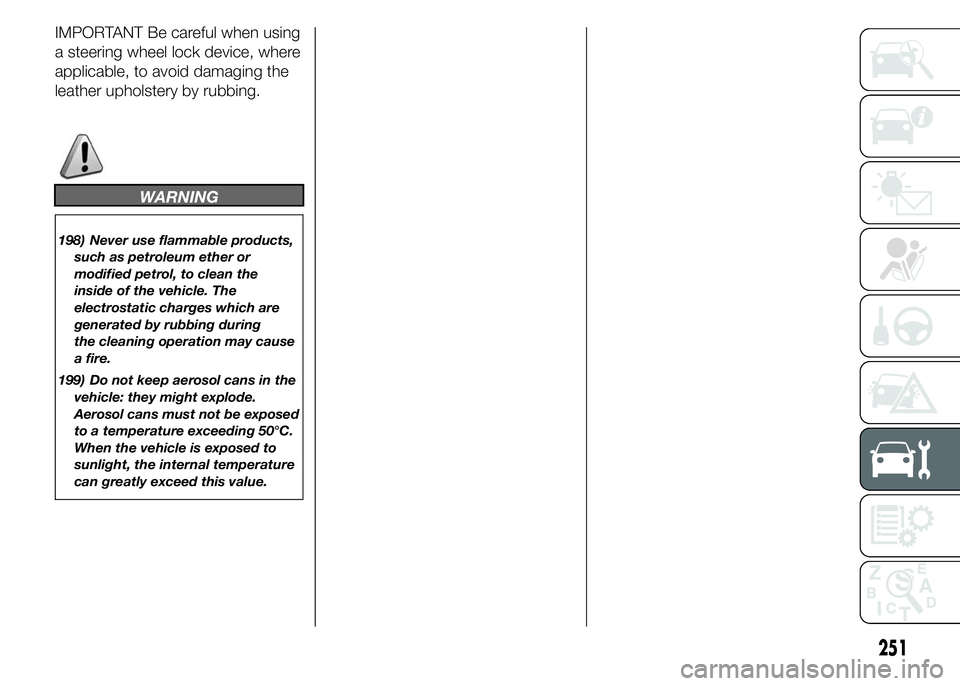
IMPORTANT Be careful when using
a steering wheel lock device, where
applicable, to avoid damaging the
leather upholstery by rubbing.
WARNING
198) Never use flammable products,
such as petroleum ether or
modified petrol, to clean the
inside of the vehicle. The
electrostatic charges which are
generated by rubbing during
the cleaning operation may cause
a fire.
199) Do not keep aerosol cans in the
vehicle: they might explode.
Aerosol cans must not be exposed
to a temperature exceeding 50°C.
When the vehicle is exposed to
sunlight, the internal temperature
can greatly exceed this value.
251
Page 256 of 367
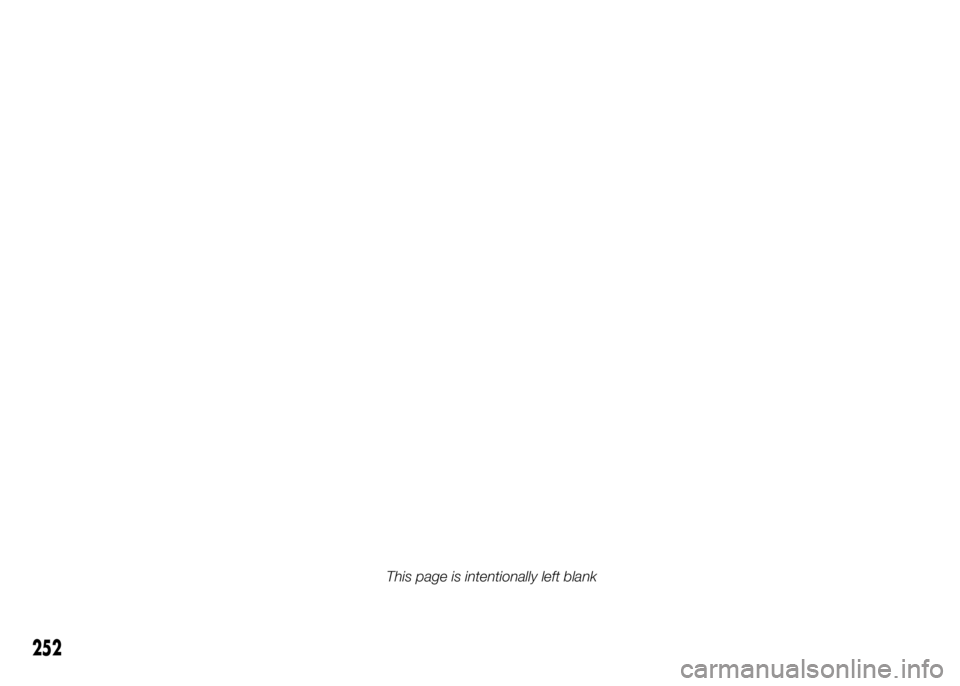
252
This page is intentionally left blank
Page 257 of 367
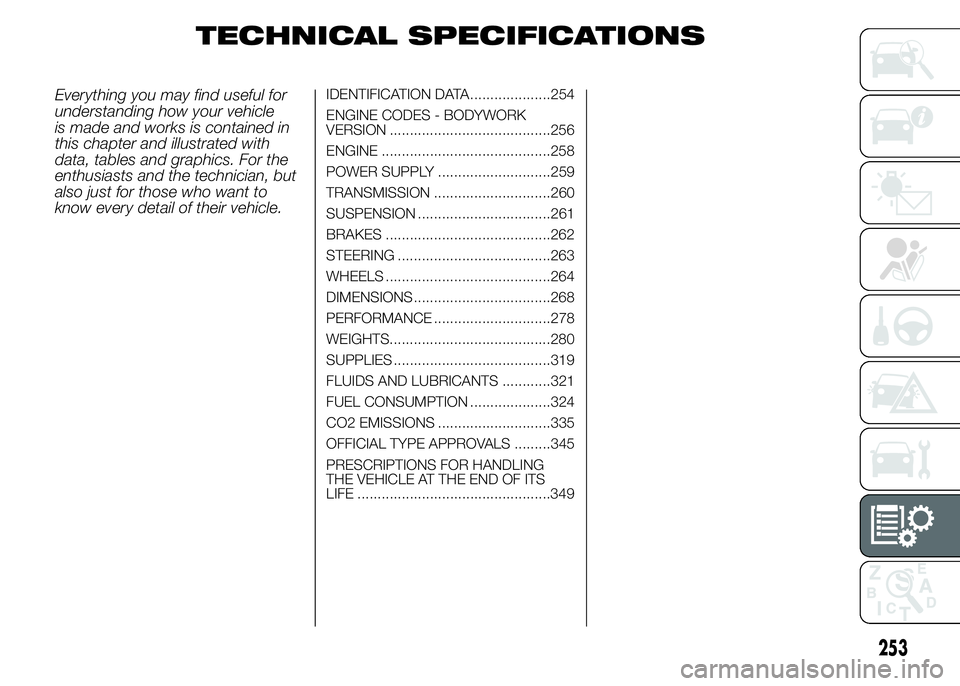
TECHNICAL SPECIFICATIONS
Everything you may find useful for
understanding how your vehicle
is made and works is contained in
this chapter and illustrated with
data, tables and graphics. For the
enthusiasts and the technician, but
also just for those who want to
know every detail of their vehicle.IDENTIFICATION DATA....................254
ENGINE CODES - BODYWORK
VERSION ........................................256
ENGINE ..........................................258
POWER SUPPLY ............................259
TRANSMISSION .............................260
SUSPENSION .................................261
BRAKES .........................................262
STEERING ......................................263
WHEELS .........................................264
DIMENSIONS ..................................268
PERFORMANCE .............................278
WEIGHTS........................................280
SUPPLIES .......................................319
FLUIDS AND LUBRICANTS ............321
FUEL CONSUMPTION ....................324
CO2 EMISSIONS ............................335
OFFICIAL TYPE APPROVALS .........345
PRESCRIPTIONS FOR HANDLING
THE VEHICLE AT THE END OF ITS
LIFE ................................................349
253
Page 258 of 367
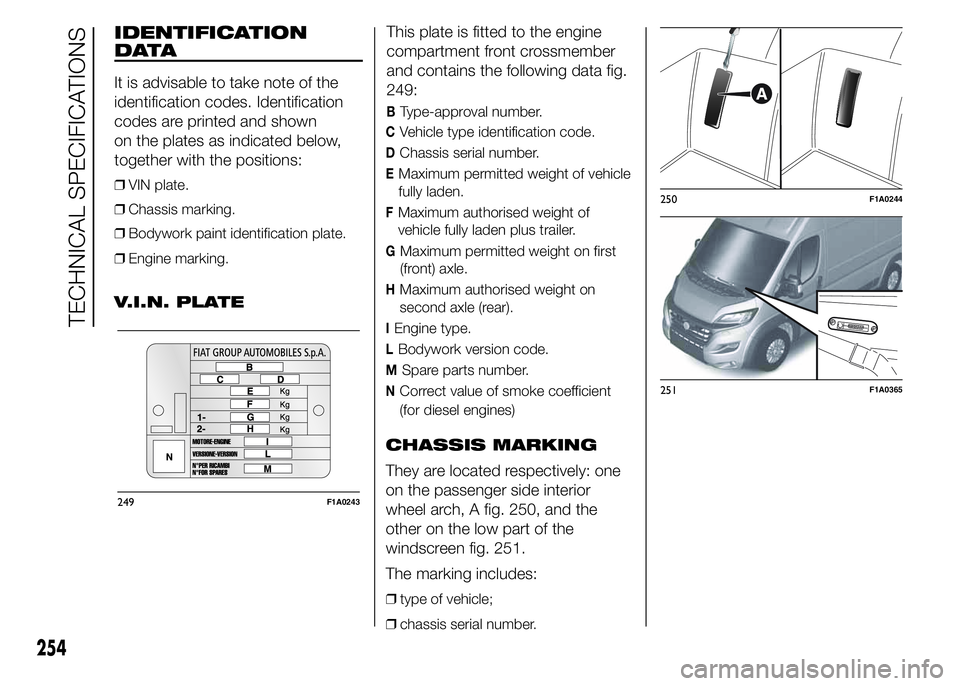
IDENTIFICATION
DATA
It is advisable to take note of the
identification codes. Identification
codes are printed and shown
on the plates as indicated below,
together with the positions:
❒VIN plate.
❒Chassis marking.
❒Bodywork paint identification plate.
❒Engine marking.
V.I.N. PLATEThis plate is fitted to the engine
compartment front crossmember
and contains the following data fig.
249:
BType-approval number.
CVehicle type identification code.
DChassis serial number.
EMaximum permitted weight of vehicle
fully laden.
FMaximum authorised weight of
vehicle fully laden plus trailer.
GMaximum permitted weight on first
(front) axle.
HMaximum authorised weight on
second axle (rear).
IEngine type.
LBodywork version code.
MSpare parts number.
NCorrect value of smoke coefficient
(for diesel engines)
CHASSIS MARKING
They are located respectively: one
on the passenger side interior
wheel arch, A fig. 250, and the
other on the low part of the
windscreen fig. 251.
The marking includes:
❒type of vehicle;
❒chassis serial number.
249F1A0243
250F1A0244
251F1A0365
254
TECHNICAL SPECIFICATIONS
Page 259 of 367
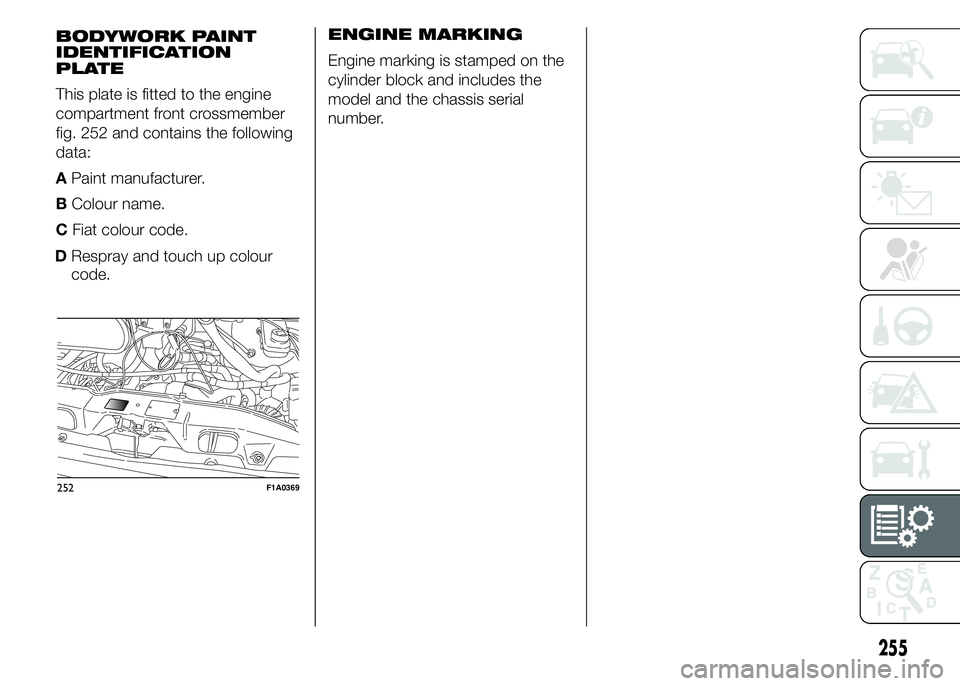
DRespray and touch up colour
code.ENGINE MARKING
Engine marking is stamped on the
cylinder block and includes the
model and the chassis serial
number.
252F1A0369
255
BODYWORK PAINT
IDENTIFICATION
PLATE
This plate is fitted to the engine
compartment front crossmember
fig. 252 and contains the following
data:
APaint manufacturer.
BColour name.
CFiat colour code.
Page 260 of 367
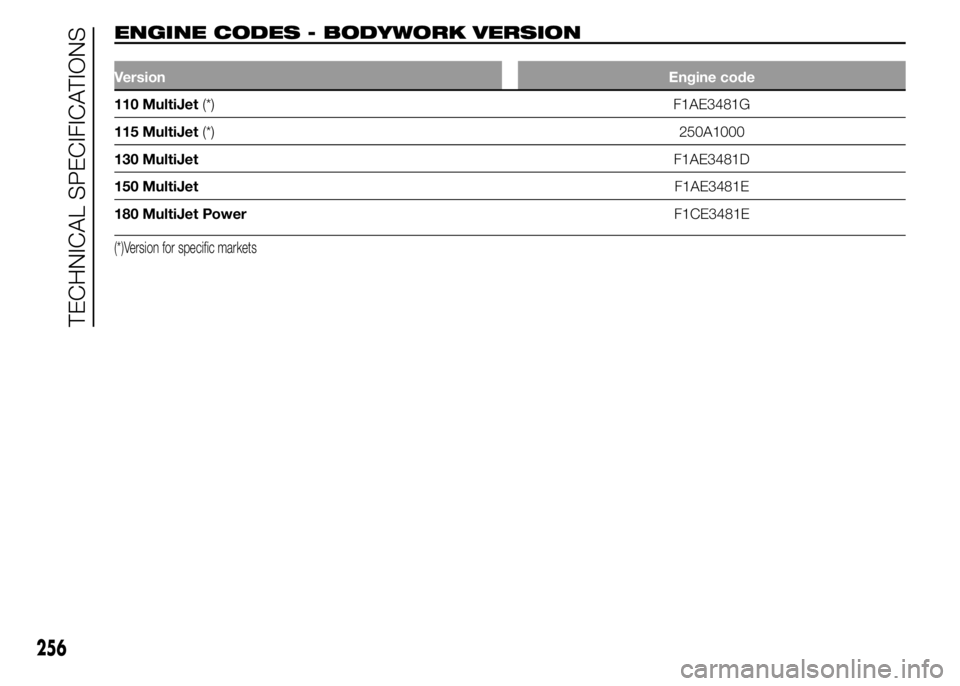
ENGINE CODES - BODYWORK VERSION.
VersionEngine code
110 MultiJet(*) F1AE3481G
115 MultiJet(*)250A1000
130 MultiJetF1AE3481D
150 MultiJetF1AE3481E
180 MultiJet PowerF1CE3481E
(*)Version for specific markets
256
TECHNICAL SPECIFICATIONS